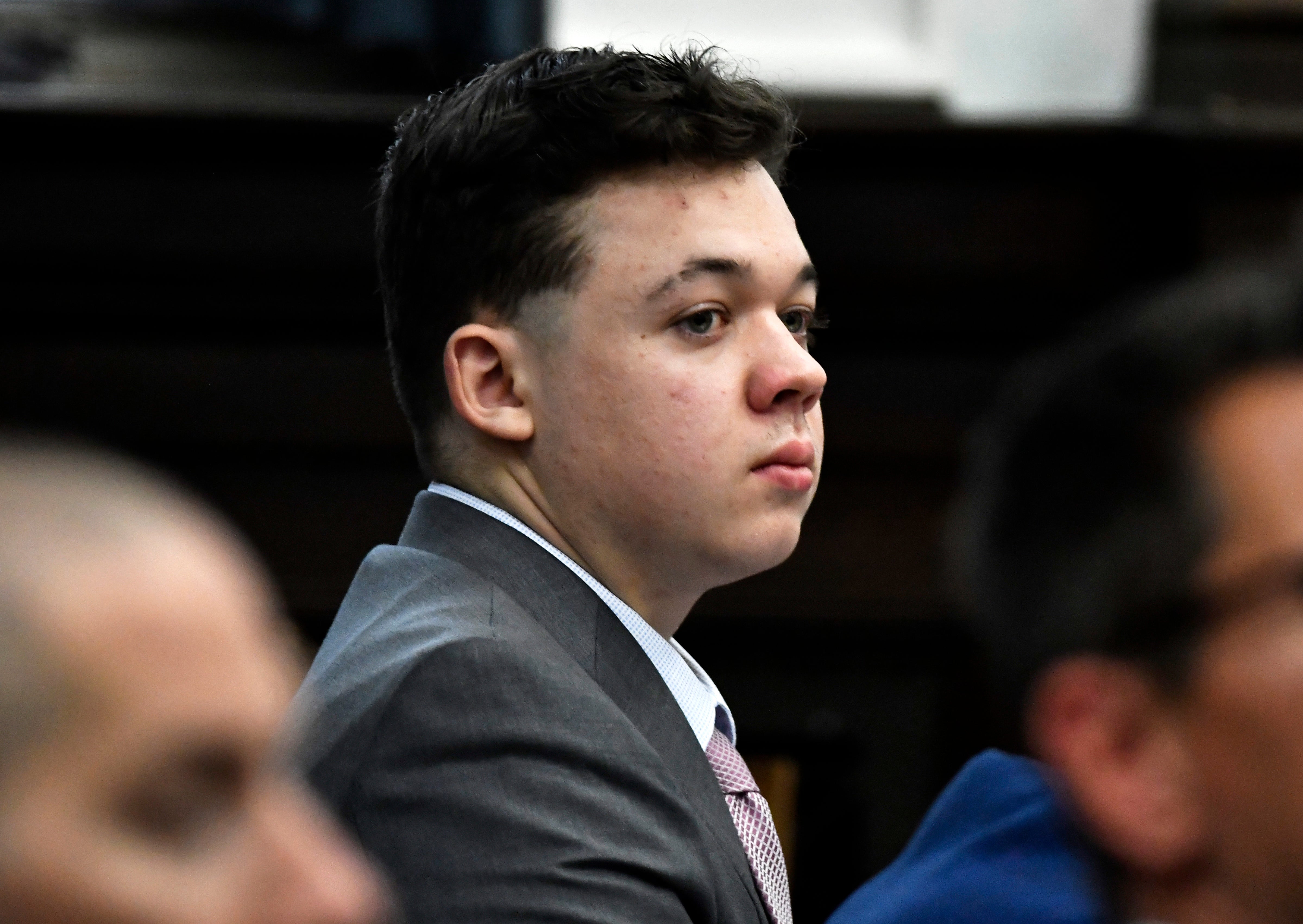How the trial of Kyle Rittenhouse and tragedy in Kenosha captured toxic American politics
The 18-year-old has been found not guilty after the case was vigorously taken up by conservative politicians and nationally televised in a 24-hour news cycle, Alex Woodward reports


A jury has determined that Kyle Rittenhouse is not guilty of homicide after killing two men, injuring another and firing several rounds from his AR-15-style rifle in the aftermath of protests against police violence in Kenosha, Wisconsin.
The jury returned a verdict on 19 November after nearly four days of deliberation and two weeks of testimony, including from Mr Rittenhouse himself, as his defence argued that he had no other choice but to shoot three men that night to save himself.
Kenosha County prosecutors – arguing their case in front of a nationally televised trial, involving shootings that were nearly entirely caught on film or streamed live – contended that it was Mr Rittenhouse who had put peoples’ lives in danger, as a “chaos tourist” who drove 20 miles from his home to insert himself in the centre of protests with a gun he was too young to buy himself, and pulled the trigger knowing it would kill.
Such claims of self-defence were not met with a sweeping inquiry into the circumstances and events that brought a then-17-year-old and his AR-15-style rifle into a volatile scene, but instead were narrowly tailored to the moments surrounding the first and last shots he fired, against Wisconsin law that grants lethal self-defence when it is “necessary to prevent imminent death or great bodily harm”.
“Hundreds of people were out in the street experiencing chaos and violence,” Kenosha County assistant district attorney, Thomas Binger, said in his opening statement. “The only person who killed anyone was the defendant.”
Mr Rittenhouse, now 18, drove from Illinois to Wisconsin in the middle of a summer of racial justice uprisings, and equipped himself with a firearm that he would later use to kill Joseph Rosenbaum and Anthony Huber and injure Gaige Grosskreutz on 25 August 2020.
He was charged with five felonies, including first-degree reckless homicide, first-degree intentional homicide and attempted first-degree intentional homicide, and two counts of recklessly endangering safety in the first degree.
Over two weeks, jurors watched more than a dozen pieces of video, including livestreams, an interview Mr Rittenhouse gave moments before he fired his gun, body camera footage, and aerial video from the FBI.
They also heard testimony from police, people who witnessed the shootings, the man who survived, and Mr Rittenhouse himself.
Following 26 hours of deliberation on the 15th day of the trial, he was found not guilty on all counts.
“I didn’t want to have to kill anybody,” he said in his emotional testimony in his own defence. “I was being attacked.”
More than a year after the shootings, the nationally televised trial brought the judge, defence attorneys, prosecutors and proceedings into a 24-hour news cycle, raising doubts about how – and whether it was even possible – to disconnect the shootings from the toxic political events surrounding them.
‘This is not a political trial’
On 23 August 2020, Kenosha police department officers responded to a domestic complaint involving Jacob Blake. As he tried to open the driver’s side door of a car, where his three children were seated in the back, officer Rusten Sheskey grabbed him and fired seven rounds. Four hit Mr Blake in the back.
The shooting was captured on video and widely shared across social media, prompting a wave of protests that night that raged throughout Kenosha’s downtown and outside the county courthouse.
Mr Blake, who is black, was left paralysed from the waist down. Officer Sheskey, who is white, did not face criminal charges, and the US Department of Justice later declined to file federal civil rights charges against him.
The shooting revived racial justice protests in a town of roughly 100,000 people on the shores of Lake Michigan, brought into sharp relief in the middle of a summer of uprisings following the police murder of George Floyd.
As protests entered a third night, local militia put out a call for armed support on social media, and Mr Rittenhouse drove roughly 20 miles from his home in Antioch, Illinois to Kenosha to patrol the streets.
“And yet in this entire sequence of events, from the shooting of Jacob Blake … all the way after that, everything this community went through, the only person who shot and killed anyone was the defendant,” Mr Binger said in his closing argument on 15 November.
“He’s intentionally and knowingly entering into a dangerous situation,” he said. “I remember that night. I didn’t come down here. I don’t think most people did. In part because we all knew it would be violent and dangerous.”
Images of Mr Rittenhouse – wearing a backwards cap and holding his AR-15-style rifle – quickly spread across social media, with some critics characterising him as a teenager who inserted himself into a story that did not belong to him, or a white supremacist arming himself against a racial justice movement.
He was also hailed as a kind of folk hero, martyr and patriot on America’s far right. Donald Trump, members of Congress and right-wing news personalities came to his defence. He has been celebrated on “Free Kyle” T-shirts and in memes, and live-streamers and far-right media personalities have cheered him and his defence attorneys in their commentary.
“This is not a political trial,” Judge Schroeder said on 1 November as jury selection was underway. “It was mentioned by both political campaigns and the presidential campaign last year, in some instances very, very imprudently.”
Judge Schroeder added that he did not want the trial “sidetracked into other issues”, such as Second Amendment rights. The judge dismissed two misdemeanor charges against Mr Rittenhouse – including illegally possessing a dangerous weapon as a minor, exploiting a loophole in Wisconsin’s open-carry law that allows minors to carry firearms over a certain barrel length.
Nick Suplina, senior vice president for law and public safety for Everytown for Gun Safety, condemned the decision, saying it is “clear that minors should not be carrying guns in public, especially at protests”.
“If the shooter wasn’t openly carrying a firearm, this tragedy would not have happened, and we wouldn’t be here listening to debates over the loopholes in state law,” he said.
Despite his insistence that the trial would not be political, politics and partisan influence dominated the case both inside and outside Judge Schroeder’s courtroom.
For more than a year, far-right media has fed their audience a false narrative that bolsters Mr Rittenhouse as a hero who stood up to their hyper-violent visions of “antifa” and Black Lives Matter protests in the wake of 2020 uprisings – and how “activist” prosecutors sought to make an example out of a “kid” who was unjustly arrested.
A foundation started by election fraud conspiracy theorist Lin Wood raised $2m for Mr Rittenhouse’s bail. Jurors heard testimony from a far-right livestreamer who called for “bloodshed” after 2020 presidential elections, then was a guest on Tucker Carlson Tonight hours after appearing on the witness stand. That night, Mr Rittenhouse’s mother Wendy appeared on Sean Hannity’s Fox programme.
Video evidence central to the defence’s motions for mistrial was also played on Tucker Carlson Tonight within days of the shooting.
Mark and Patricia McCloskey, the St Louis, Missouri couple who brandished firearms at Black Lives Matter protesters last year, also appeared outside the Kenosha County Courthouse as jury deliberations were underway.
Jurors also were not allowed to see images of Mr Rittenhouse – wearing a “Free As F***” T-shirt – flashing an apparent white supremacist-signaling “OK” hand gesture with a group of alleged members of the nationalist Proud Boys gang four months after the shooting. Judge Schroder deemed such evidence “too prejudicial”.
Whether Wisconsin’s law was on Mr Rittenhouse’s side, “acquittal does not make a foolish man a hero”, David French writes in The Atlantic. “A political movement that turns a deadly and ineffective vigilante into a role model is a movement that is courting more violence and encouraging more young men to recklessly brandish weapons in dangerous places, and that will spill more blood in America’s streets.”
Defence attorney Mark Richards accused prosecutors of waging their own political campaign, “marching forward because they need somebody to be responsible” for the protests that upended Kenosha, he said.
“They need someone to say, ‘He did it, he is the one who brought terror to Kenosha.’”
‘Should self-defence claims be treated equally?’
The case has also revived debate over the growing presence of militarised civilians and self-styled militia responding to racial justice protests, and whether the American right’s violent embrace of Second Amendment protections comes at the expense of the First Amendment.
The verdict arrived in the middle of the trial for three white men accused of murdering Ahmaud Arbery, a black man, in Georgia, as well as a civil trial against the organisers of the 2017 Unite the Right rally in Charlottesville, Virginia.
In the case of Mr Rittenhouse, the nation had tuned into a jury trial for the kind of case that may typically end in a plea agreement, unless the defendant can afford a costly defence.
But the trial has also intensified scrutiny into the permissiveness of lethal self-defence claims in a country filled with guns, against prosecutors’ responsibility to disprove them, and whether firing a gun that ends up killing someone who is perceived as a threat bears any consequence.
“Is this a case about the broader protests … or is the job of the court to apply in an even-handed fashion the rules that present an opportunity to raise a self-defence claim?” said Professor Nicholas Johnson, of Fordham University School of Law. “Should self-defence claims be treated equally?”
“Does the fact you go out in public with a rifle [mean] you are more readily anticipating confrontation, as opposed to handgun which you might put in your pocket?” he added. “People who move beyond the pure uncontestable self-defence scenario – the surprise attack people were not anticipating – and people who go out in an environment of public unrest, armed, are taking a greater risk.”
People “injecting” themselves into public unrest “should sort of expect that they might really have to navigate the legal bureaucracy and sustain the legitimacy of using violence”, he said.
“We have blurred every line,” Kimberly Kessler Ferzan, a professor of law and philosophy at the University of Pennsylvania, has argued. “What is [defence]? What is reasonable? When may one stand one’s ground and when must one retreat? And when is a citizen entitled to step in as an aggressor in the name of the state?”
In his closing remarks, assistant district attorney James Kraus said “you don’t just get to immediately shoot someone. It is not reasonable for any person to not try to defend yourself first using other methods.”
“Why do you get to immediately just start shooting?” he said. “It’s not up to Mr Rittenhouse to be the judge, the jury, and eventually the executioner.”
Subscribe to Independent Premium to bookmark this article
Want to bookmark your favourite articles and stories to read or reference later? Start your Independent Premium subscription today.
